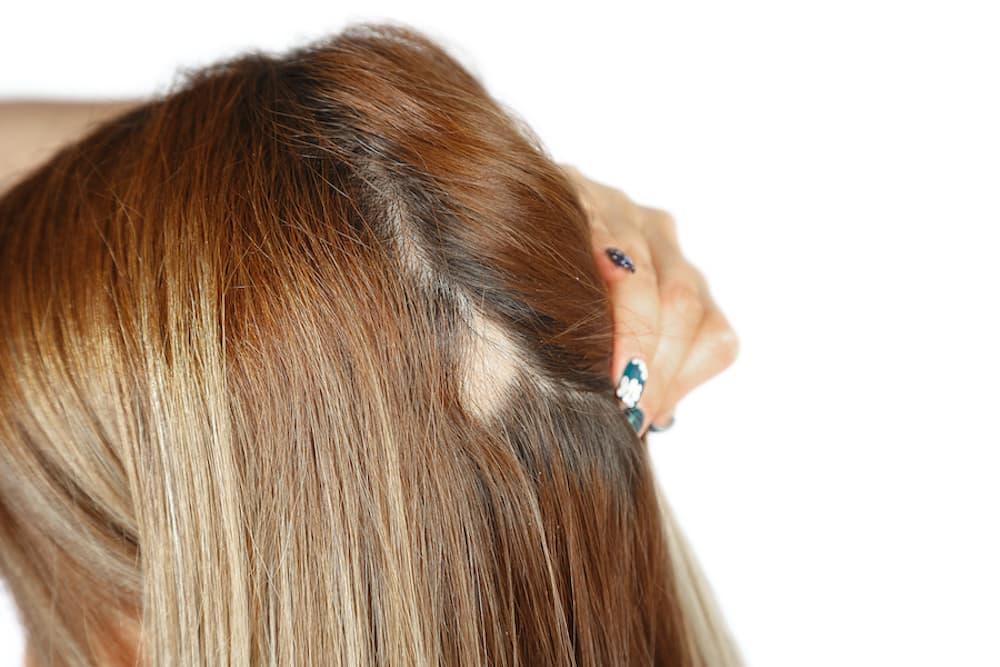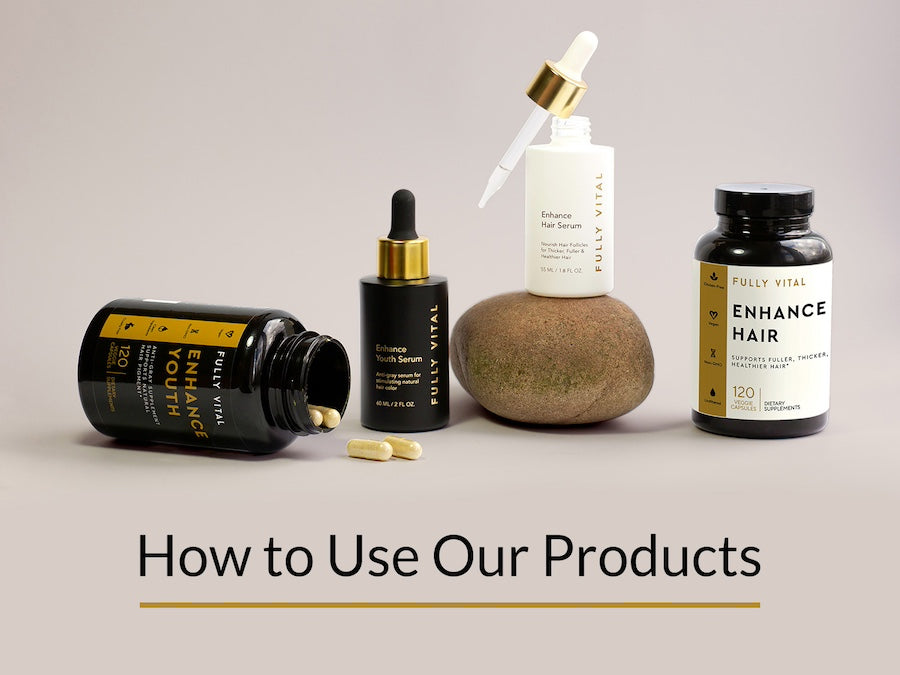
7 Daily Habits That Are Damaging Your Hair
Do you notice increased hair shedding in the shower or on the pillow?
Is your hair dry or brittle and breaks easily? Do you notice less shine on your hair?
Did you know that a few “normal” daily habits could be causing hair thinning and
lackluster hair?
Don’t fret. Just a few habit changes will reduce the physical and biological stress on your hair – and give it a chance to bloom.
Let’s dive in.
Hair Thinning Habit #1: Using Hair Care Products That Harm Your Scalp
What you put on your hair matters. Most hair care companies, even the big brands, add ingredients to their products that are known to be hormone disruptors and potential carcinogens.
The list includes parabens, benzoates, phthalates, sodium laureth sulfate (SLS) and artificial fragrances.
Why are these ingredients in your hair products? They are typically used as emulsifiers, thickening agents and surfactants.
They can add a rich creamy lather to your shampoo or blend the other ingredients better.
A big reason for hair thinning in both men and women is due to an overabundance of androgens (male hormones such as DHT) circulating in your scalp.
These androgens cause thinning of your hair and lead to hair loss.
It’s important to avoid hormone disruptors from your hair and bath products, as these may upset the delicate balance on your scalp and make your hair loss worse.
These chemicals can also damage the hair follicle cells which produce your hair. Let’s face it, you don’t need to add additional damage to the very cells that are responsible for growing hair.
Hair Wellness Tip #1: Next time you’re shopping for hair or beauty products, look at the ingredient listing and prefer products that do not contain parabens, benzoates, phthalates and SLS.
For this reason, the FullyVital hair wellness system is 100% natural and contains none of these chemicals.
Hair Thinning Habit #2: Overexposure To The Sun
It's fashionable to post images tanning poolside or on a tropical beach to make your friends jealous, but too much exposure to the sun can actually accelerate hair thinning.
But isn’t vitamin D from the sun healthy? Yes, it is – in small doses.
Most people just need a daily sun exposure of 15-30 minutes. Any more can start to damage your cells and cause faster aging!
When you expose your hair to the sun for long periods, it results in lightening (for
brunettes) or bleaching (for blondes).
While some women like the lightening effect caused by sunlight, it’s actually a sign of hair damage.
Blonde hair develops yellowing which is due to the oxidation of the sulfur molecules within the blonde hair shaft.
Brunette hair gets reddish spots because of oxidation of melanin pigments. These lead to hair that becomes brittle, dry and tangles easily.
Secondly, the sun’s rays cause free radical and DNA damage in cells of your epidermis (and even as far as the dermis, your inner skin layer).
Your body must spend precious resources repairing these cells. Instead of growing thick and strong hair, your hair follicle cells are spending energy trying to survive.
It’s time to stop laying out in the sun for hours, for the sake of your hair (and skin).
Hair Wellness Tip #2: Expose your body to about 15-30 minutes of sunlight per day. After this time, make sure to wear a hat and apply a clean sunscreen liberally.
Hair Thinning Habit #3: Constant Pulling and Tugging On Hair
The way you style your hair matters. Braids, cornrows, tight ponytails, pigtails and buns put constant tension on the hair follicles near the root.
Constant tension on your roots forces the hair out of the follicle prematurely. This leads to hair loss, especially on the outer edges of the braid or ponytail where the greatest tension is experienced.
In rare cases, the constant tension can lead to scarring and permanent hair loss over time. This condition is called traction alopecia. It can occur at any age and is more common in women.
Interestingly, even hair extensions can put pressure on your hair follicles and cause hair thinning over the long term.
Hair Wellness Tip #3: Stop tying your hair in tight hairstyles. Loosen up and wear your hair down when possible. If you do need to wear a tight hairstyle, do it only for short periods of time.
Use a soft scrunchy or a hair-friendly hair tie. Anytime you feel your hair tugging on your roots, it’s an opportunity to loosen up.
Avoid hair extensions. If you must use hair extensions, prefer the clip-in versions
instead of the glue-in versions and take them off at home.
Hair Thinning Habit #4: Treating Your Hair With High Heat
We get it. You love your hot showers as much as the next person.
But just as hot water dehydrates your skin, it also stresses and dehydrates your hair strands leaving them brittle and prone to snapping.
If hot showers are combined with a shampoo that strips your scalp of protective oils, this one-two combo can lead to excessive dehydration and forces your scalp to produce excess sebum.
Over time, this overworking damages your roots and lead to additional shedding.
Most women use heat styling tools such as curling irons, tongs, flatirons and blow
dryers to style hair.
High heat styling tools such as flatirons leads to hair that is excessively dry, brittle and breaks easily.
High heat destroys the natural hydrogen bonds in your hair and strips your hair of its natural proteins.
The breakage of hydrogen bonds is how these tools help you change your hair texture – to straight or curly.
Hair Wellness Tip #4: Stop using styling tools at a high heat setting. Prefer to use the medium heat setting instead.
If your hair is damaged or you are experiencing hair thinning, it best to give your hair a rest and be extremely gentle with your hair.
Use medium temperature water in the shower to achieve more moisture retention and stronger hair.
Hair Thinning Habit #5: Being Rough With Your Hair
Many movies depict a female actor rubbing her wet hair vigorously with a towel after a shower.
But vigorously rubbing your hair with a towel causes friction between hair strands, leading to cuticle and hair damage.
The same principle applies when you shampoo your hair. Aggressively scrubbing your scalp during shampooing may cause brittleness and split ends.
Hair Wellness Tip #5: It’s best to pat dry your hair with a microfiber towel and let it air dry. Treat your hair gently while shampooing. Avoid or reduce application of chemical treatments on your hair.
Hair Thinning Habit #6: Chemical Processing In Your Hair
Plenty of women use chemical treatments on their hair such as perms, bleach and hair dyes. Your hair shaft contains bonds of keratin proteins that block penetration of water into the interior of the shaft.
Perms break up the bonds protecting your hair shaft and allow water to enter the inside layers of your hair cuticle.
Hair dyes contain a cocktail of bad chemicals such as ammonia, hydrogen peroxide sensitizers like papaphenyenediamine (PPDA).
Ammonia causes your hair shaft to swell up and allows the hair dye to penetrate the protective hair cuticles. Hydrogen peroxide destroys your hair’s natural color while also drying it.
Thus, ingredients used in hair dyeing can damage your hair and cause breakage and hair loss over time. Bleaching your hair comes with its own set of challenges. Bleaching swells up your hair to allow oxidizing agents like hydrogen peroxide to dissolve your melanin, which provides your natural hair color.
Bleaching causes your hair to become porous. When your hair gets very porous, it becomes almost impossible to hold any style.
Bleaching causes the inner part of the hair shaft to become exposed, causing split ends and hair breakage.
Chemical processing in your hair leads to dry, brittle hair that breaks easily and can lead to hair loss.
Hair Wellness Tip #6: Skip the chemicals and treat hair using natural methods to color hair.
Hair Thinning Habit #7: Eating Too Much Fish
You have probably heard the recommendation to eat more fish and seafood in general. Fish is one of the healthiest foods you can eat. It is rich in essential fatty acids EPA and DHA, which are critical for the brain and help moisturize your skin.
However, certain types of fish contain mercury which is highly toxic and causes cause hair loss.
Mercury is a heavy metal that is released by industrial processes. It makes its way into the ocean and is absorbed by fish.
Larger fish live for longer and eat smaller fish for food. The heavy metals in the small fish get transferred to the large fish, and they continue accumulating over time.
When you eat a fish with accumulated heavy metals, you will ingest them into your body.
Heavy metals such as mercury, lead, arsenic and others are associated with increased hair loss.
Hair Wellness Tip #7: Limit seafood to 2x per week. When eating seafood, prefer to eat smaller fish such as sardines, anchovies and salmon. These tend to have the least amount of mercury.
Conclusion:
These are 7 of the most common hair habit mistakes we come across when helping women and men get thicker, stronger and fuller hair.
Stop damaging your hair with the preventative techniques listed above so that your hair can bloom.
The next step is to use our FullyVital hair wellness system to reverse the damage and get the thicker, fuller hair you deserve.
Stay young and prosper.




